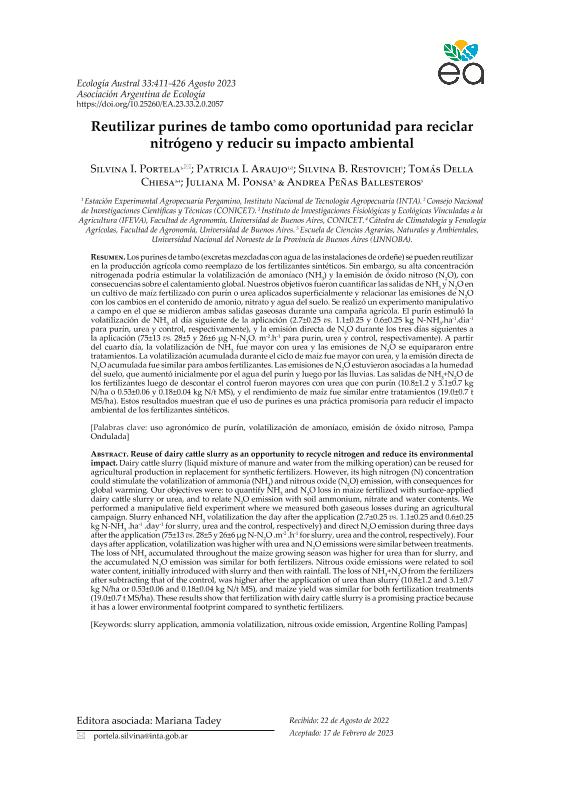Artículo
Los purines de tambo (excretas mezcladas con agua de las instalaciones de ordeñe) se puedenreutilizar en la producción agrícola como reemplazo de los fertilizantes sintéticos. Sin embargo, su altaconcentración nitrogenada podría estimular la volatilización de amoníaco (NH3) y laemisión de óxido nitroso(N2O), con consecuencias sobre el calentamiento global. Nuestros objetivos fueron cuantificar las salidas deNH3 y N2O en un cultivo de maíz fertilizado con purín o urea aplicados superficialmente y relacionar lasemisiones de N2O con los cambios en el contenido de amonio, nitrato y agua del suelo. Se realizó un experimentomanipulativo a campo en el que se midieron ambas salidas gaseosas durante una campaña agrícola. El purínestimuló la volatilización de NH3 al día siguiente de la aplicación (2.7±0.25 vs. 1.1±0.25 y 0.6±0.25 kg N-NH3.ha-1.dia-1 para purín, urea y control, respectivamente), y la emisión directa de N2O durante los tres díassiguientes a la aplicación (75±13 vs. 28±5 y 26±6 µg N-N2O m-2.h-1 para purín, urea y control, respectivamente). A partir del cuarto día, la volatilización de NH3 fue mayor con urea y las emisiones de N2O se equipararonentre tratamientos. La volatilización acumulada durante el ciclo de maíz fue mayor con urea, y la emisióndirecta de N2O acumulada fue similar para ambos fertilizantes. Las emisiones de N2O estuvieron asociadas ala humedad del suelo, que aumentó inicialmente por el agua del purín y luego por las lluvias. Las salidas de NH3 + N2O de los fertilizantes luego de descontar el control fueron mayores con urea que con purín (10.8±1.2y 3.1±0.7 kg N/ha o 0.53±0.06 y 0.18±0.04 kg N/t MS), y el rendimiento de maíz fue similar entre tratamientos(19.0±0.7 t MS/ha). Estos resultados muestran que el uso de purines es una práctica promisoria para reducirel impacto ambiental de los fertilizantes sintéticos. Dairy cattle slurry (liquid mixture of manure and water from the milking operation) can be reused for agricultural production in replacement for synthetic fertilizers. However, its high nitrogen (N) concentration could stimulate the volatilization of ammonia (NH3 ) and nitrous oxide (N2 O) emission, with consequences for global warming. Our objectives were: to quantify NH3 and N2 O loss in maize fertilized with surface-applied dairy cattle slurry or urea, and to relate N2 O emission with soil ammonium, nitrate and water contents. We performed a manipulative field experiment where we measured both gaseous losses during an agricultural campaign. Slurry enhanced NH3 volatilization the day after the application (2.7±0.25 vs. 1.1±0.25 and 0.6±0.25 kg N-NH3 .ha-1 .day-1 for slurry, urea and the control, respectively) and direct N2 O emission during three days after the application (75±13 vs. 28±5 y 26±6 µg N-N2 O .m-2 .h-1 for slurry, urea and the control, respectively). Four days after application, volatilization was higher with urea and N2 O emissions were similar between treatments. The loss of NH3 accumulated throughout the maize growing season was higher for urea than for slurry, and the accumulated N2 O emission was similar for both fertilizers. Nitrous oxide emissions were related to soil water content, initially introduced with slurry and then with rainfall. The loss of NH3 +N2 O from the fertilizers after subtracting that of the control, was higher after the application of urea than slurry (10.8±1.2 and 3.1±0.7 kg N/ha or 0.53±0.06 and 0.18±0.04 kg N/t MS), and maize yield was similar for both fertilization treatments (19.0±0.7 t MS/ha). These results show that fertilization with dairy cattle slurry is a promising practice because it has a lower environmental footprint compared to synthetic fertilizers.
Reutilizar purines de tambo como oportunidad para reciclar nitrógeno y reducir su impacto ambiental
Título:
Reuse of dairy cattle slurry as an opportunity to recycle nitrogen and reduce its environmental impact
Portela, Silvina Isabel; Araujo, Patricia Inés ; Restovich, Silvina Beatriz; Della Chiesa, Tomás
; Restovich, Silvina Beatriz; Della Chiesa, Tomás ; Ponsa, Juliana M.; Peñas Ballesteros, Andrea
; Ponsa, Juliana M.; Peñas Ballesteros, Andrea
 ; Restovich, Silvina Beatriz; Della Chiesa, Tomás
; Restovich, Silvina Beatriz; Della Chiesa, Tomás ; Ponsa, Juliana M.; Peñas Ballesteros, Andrea
; Ponsa, Juliana M.; Peñas Ballesteros, Andrea
Fecha de publicación:
04/2023
Editorial:
Asociación Argentina de Ecología
Revista:
Ecología Austral
ISSN:
0327-5477
Idioma:
Español
Tipo de recurso:
Artículo publicado
Clasificación temática:
Resumen
Archivos asociados
Licencia
Identificadores
Colecciones
Articulos(IFEVA)
Articulos de INST.D/INV.FISIOLOGICAS Y ECO.VINCULADAS A L/AGRIC
Articulos de INST.D/INV.FISIOLOGICAS Y ECO.VINCULADAS A L/AGRIC
Articulos(SEDE CENTRAL)
Articulos de SEDE CENTRAL
Articulos de SEDE CENTRAL
Citación
Portela, Silvina Isabel; Araujo, Patricia Inés; Restovich, Silvina Beatriz; Della Chiesa, Tomás; Ponsa, Juliana M.; et al.; Reutilizar purines de tambo como oportunidad para reciclar nitrógeno y reducir su impacto ambiental; Asociación Argentina de Ecología; Ecología Austral; 33; 2; 4-2023; 411-426
Compartir
Altmétricas



